Portrait Justine Emard par Fisheye immersive
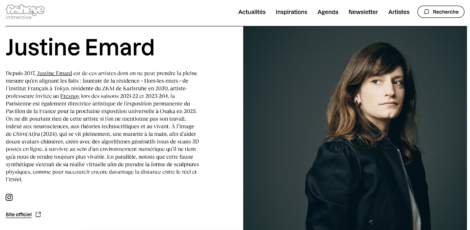
Presse, podcasts & interviews (sélection)
2025
- Architectures Cree Magazine, novembre 2025, Pavillon France, Exposition Universelle d’Osaka, par Stéphanie Philippe
- France Culture, novembre 2025, « Intelligence artificielle » : une exposition interactive à la Cité des Sciences à Paris, Un monde connecté, par François Saltiel
- Mangrana Magazine, Espagne, Justine Emard, un diàleg amb la IA par Jael Violant Roméo González
- Fisheye immersive – Exposition universelle d’Osaka 2025 : l’IA sous toutes ses formes, par Zoé Terouinard
- France Culture, Soft Power, avril 2025 – interview à 1:15:42, Japon-Cool Japan : comment le Japon relance son influence avec l’exposition universelle, par Frédéric Martel
- Fisheye Immersive, mars 2025 , Justine Emard : « Je me bats pour la conservation des œuvres d’art numérique » , par Maxime Delcourt
- Fisheye Immersive, mars 2025, Newsletter 46, par Justine Emard, rédactrice en chef invitée
- Twist Arte, mars 2025, Quel est l’impact de nos rêves ? réalisation Wero Jägersberg – de 15’28 à 23’28
- ADN, janvier 2025, Justine Emard : l’artiste qui aimait les sciences, par Lila Meghraoua
2024
- Fisheye immersive, Novembre 2024, Portrait Justine Emard, artiste de la semaine
- La French Touch, Novembre 2024, Justine Emard : « L’IA est trop souvent réduite à un simple outil », par Alice D’Orgeval
English : Justine Emard: “AI is too often reduced to a simple tool” - « Recherche et intelligence artificielle » Culture et Recherche n°147, automne-hiver 2024, Revue du Ministère de la Culture, de l’enseignement et de la recherche
Hyperphantasia, des origines de l’image, par Justine Emard - Transfuge, Novembre 2024, Trois Révélations Art, par Julie Chaizemartin
- L’œil Magazine, Novembre 2024 (web et print), Les artistes à la conquête de l’espace, par Stéphanie Lemoine
- L’œil Magazine, Octobre 2024 (web et print), La petite fabrique des songes, par Marie Zawisza
- Fisheye immersive, Octobre 2024, Panorama 26, aux frontières du réel, par Maxime Delcourt
- Musée des Confluences, Octobre 2024, Les Mondes des Reves, L’art de rêver, épisode 5
- HacnuMedia, Octobre 2024, Choisir un modèle d’IA, le casse-tête des artistes (2/2), par Adrien Cornelissen
- Fisheye immersive, Septembre 2024, Encoder l’espace, l’expo qui regarde vers l’infini et l’au-delà, par Maxime Delcourt
- Libération, Mai 2024, «Artificial Dreams», les jeux d’artifices du Grand Palais Immersif, par Gilles Renault
- Connaissance des arts, Mai 2024, Exposition immersive à Paris : 12 nocturnes exceptionnelles qui nous transportent au-delà de nos rêves, par Myriam Boutoulle
- HacnuMedia, Mai 2024, Choisir un modèle d’IA, le casse-tête des artistes (1/2), par Adrien Cornelissen
- Contemporary Art Issue, Avril 2024, Top 20 Most Famous Digital Artists Today, A Reasoned Anthology par Julien Delagrange
- Radio-Canada, Vancouver, Avril 2024, Entrevue avec Justine Emard : l’IA et l’art à la nuit des idées, par Grégory Bernard
- PCA-Stream, Avril 2024, L’art de la vie artificielle
- Libération, Mars 2024, Interview Justine Emard pour Le Printemps des Humanités «Voir une machine apprendre est quelque chose de très beau» par Benjamin Leclercq
- Le Figaro, Février 2024, «Le processus est fascinant»: comment les artistes de l’IA veulent révolutionner la création visuelle, par Klara Durand
2023
- Le Quotidien de l’Art, Décembre 2023, « Art et neurosciences : le cerveau, médium transgressif » Par Judith Chetrit
- Fisheye immersif, Décembre 2023, « Hyperphantasia » : l’art vidéo immersif s’invite à la grotte préhistorique du Lazaret, par Zoé Terouinard
- Libération, Décembre 2023, Artistes et intelligence artificielle : brassages comme des images, par Christelle Granja
- Arte, Emission Twist, France et Allemagne, Octobre 2023, « Twist : Surréaliste ! Le pouvoir des rêves »
- KingKong Mag, Belgique, Juin 2023, Justine Emard, Human After All? par Adrien Cornelissen
- Youtube, Ministère de la Culture, Palais de Tokyo, Juin 2023, 4e Parlement de la photographie | « IA, de nouvelles épreuves pour la photographie ? », Modération : Clémentine Mercier
- Radio Nova, Mai 2023, Justine Emard : de l’art plein les neurones, Du Beau monde,par Silouane Bourel
- Le Studio Cosmique, Observatoire de l’Espace du Cnes, Rendre sensibles les données de l’Espace, Studio cosmique : le studio radio éphémère avec Justine Emard, par David Christoffel
- In conversation with Justine Emard, Now or Never Art Trail, Experimenta Biennale, Australia 2023, In conversation with Justine Emard
- Interview, Mai 2023, Intelligence artificielle et spectacle vivant : rencontre avec l’artiste Justine Emard, par Marion Carré
- Revue l’art même, Janvier 2023, Hyperphantasia, des origines de l’image
- Beaux-Arts magazine, Mai 2023, « Quatre plasticiens stupéfiants qui marient art et technologies », par Maïlys Celeux-Lanval
2022
- Libération, Décembre 2022, « Intelligence artificielle : ces artistes qui en font leur big dada », par Clémentine Mercier
- Stirworld, Décembre 2022, « SAF 2022: An exhibition challenging how we see the image in the age of Web 3.0 », by Sukanya Deb
- Percées, UQAM, Novembre 2022, [Ap]prendre (soin) dans le contact, un entretien avec Justine Emard mené par Julie-Michèle Morin
- France Culture, Septembre 2022, Intelligence artificielle : J’aurais voulu être un artiste, Emission La Science CQFD, Natacha Triou
- Libération, Septembre 2022, Dans l’art, l’imprévisible fait impression, Christelle Granja
- ART PRESS, Août 2022, IMAGE 3.0, Dominique Moulon
- MONOPOL – Magazin für Kunst und Leben, Juillet 2022, Künstlerin Justine Emard – « Vielleicht können wir von der Maschine lernen »
- L’artiste Justine Emard – « Peut-être pouvons-nous apprendre de la machine », Philippe Hindahl
- L’Œil, Juillet 2022, Vies artificielles, Stéphanie Lemoine
- L’Œil, Juillet 2022, À la pointe de l’image, Christine Coste
- Art Press, Juin 2022, « Biomedia, l’ère des médias semblables à la vie », Dominique Moulon
- Connaissance des Arts, Mars 2022, « Justine Emard, au delà du réel », Véronique Bouruet-Aubertot
- Beaux Arts Magazine, Janvier 2022, « L’odyssée fantastique de l’art à la conquête de l’espace« , Inès Boittiaux
2021
- L’ŒIL n°749 du 1 décembre 2021 & le Journal des Arts
« 20 artistes qui veulent changer le monde », Stéphanie Lemoine et Anne-Cécile Sanchez
https://www.lejournaldesarts.fr/creation/20-artistes-qui-veulent-changer-le-monde-157663 - Art of Change 21
« Réinitialiser le monde par l’art après l’échec de la COP26 », Stefano Vendramin et Alice Audouin - L’ŒIL n°746 du 1 septembre 2021 & le Journal des Arts
« Le non-humain de l’abeille à l’IA », Stéphanie Lemoine - Art press, Octobre 2021
« Hyper Organisms », Thibaut Hofer - ZKM, Center for Art and Media Karlsruhe, Germany
« Justine Emard | Supraorganism, artist talk » video 8’43 - Google Arts & Culture x ZKM Hertz Lab
Artificial intelligence - Slanted #37 : Artificial Intelligence, Slanted Publishers
- « L’énigme autodidacte », Fomo Vox
- École Supérieure d’Art de Clermont Métropole
« Portrait Alumni de Justine Emard » par Manon Pretto - Revue AS (Actualité de la Scénographie)
« Art media et récits transhumanistes », Adrien Cornelissen - Podcast Extra, Ambassade de France en Belgique
« Extra2021-Justine Emard »
2020
- Institut Français, Novembre 2020
Interview Justine Emard « Au-delà de la rencontre, c’est l’altérité qui m’intéresse. »
ENG : « Beyond the encounter itself, I am interested in otherness » - Art Press, Juin 2020
Gestes techniques, gestes technologiques? Magali Nachtergael - HACNUM, DGCA, Ministère de la culture
Entretien pour le Guide « Aide à la création en environnement numérique » - Le Figaro, Mars 2020
Stay in your shell, journal d’un confinement en forme de coquillage, Valérie Duponchelle
(pour voir la série : https://justineemard.com/stay-in-your-shell/) - Madame Figaro, Avril 2020
Digitale attidude « Les 10 femmes de l’année », Alice D’Orgeval - Tempura magazine
Mon beau robot, rencontre avec Justine Emard, Christelle Granja - Zérodeux
Dancing Machines, Ilan Michel - Le Journal des Arts
L’intelligence artificielle s’infiltre dans l’art contemporain, Stéphanie Lemoine - Beaux-Arts Magazine
L’intelligence artificielle va-t-elle remplacer les artistes ? Maïlys Celeux-Lanval - Mouvement
Dancing Machines, Léa Poiré - Revue Espaces
Et si l’intelligence n’existait pas? Nathalie Bachand
2019
- CNC, Centre National de la Cinématographie
Justine Emard, l’intelligence artificielle explorée par l’art, Paris, France - Maudit Français
Co(AI)xistence de Justine Emard : la collaboration entre deux intelligences, Québec, Canada - Frieze
The best exhibitions in Tokyo, Andrew Maerkle - Artnet, How to speak robot, Tim Schneider
- Télérama, Quand les nouvelles technologies repoussent les frontières de l’art contemporain, Stéphane Renault
- Art Press, Le Chef-d’œuvre du moment
- Art Press, Jusqu’ici tout va bien, Archéologie d’un monde numérique, Dominique Moulon
- Juliet Art Magazine, We, Humans. Between art and AI in London
- Japan Times, Roppongi Crossings: The right connections, John Tran
- The Telegraph, AI more than human, Barbican: fascinating questions, robotics answers, Harry de Quetteville
- Revue AS (actualités de la scénographie), Machines de création : art, robots et spectacle vivant, Maxence Grugier
2018
- Numéro, Who is Yuko Hasegawa, a japanese art authority ?
- La croix, Les Méandres raffinés de l’art japonais
- Le Figaro, Les japonismes, Valérie Duponchelle
- Art Absolument, Fukami, Voyage esthétique dans l’archipel, Isabelle Charrier
- Ruhr Nachrichten, Mensch gegen Maschine
2017
- Art Forum, Forest for the Clouds, Kate Sutton
- Frieze, 7th Moscow Biennale, Aliya Say
- Art in America, Permanent revolutions, Brian Droitcour
- Art Tribune, Tra arte e potere. La settima Biennale di Mosca
- Mdz, 7 Biennale in Moskau: visionär zwischen Himmel und Erde
- Casa Vogue, Bienal de Moscou aponta para o futuro do planeta e da humanidade
(…)
Textes (sélection)
2024 – Hyperphantasia, des origines de l’image, par Justine Emard
« Recherche et intelligence artificielle » Culture et Recherche n°147, automne-hiver 2024
Revue du Ministère de la Culture, de l’enseignement et de la recherche
2011 – Texte de Gallien Déjean
Exposition « Première »,Centre d’Art Contemporain de Meymac, France
CATALOGUES & LIVRES (sélection)
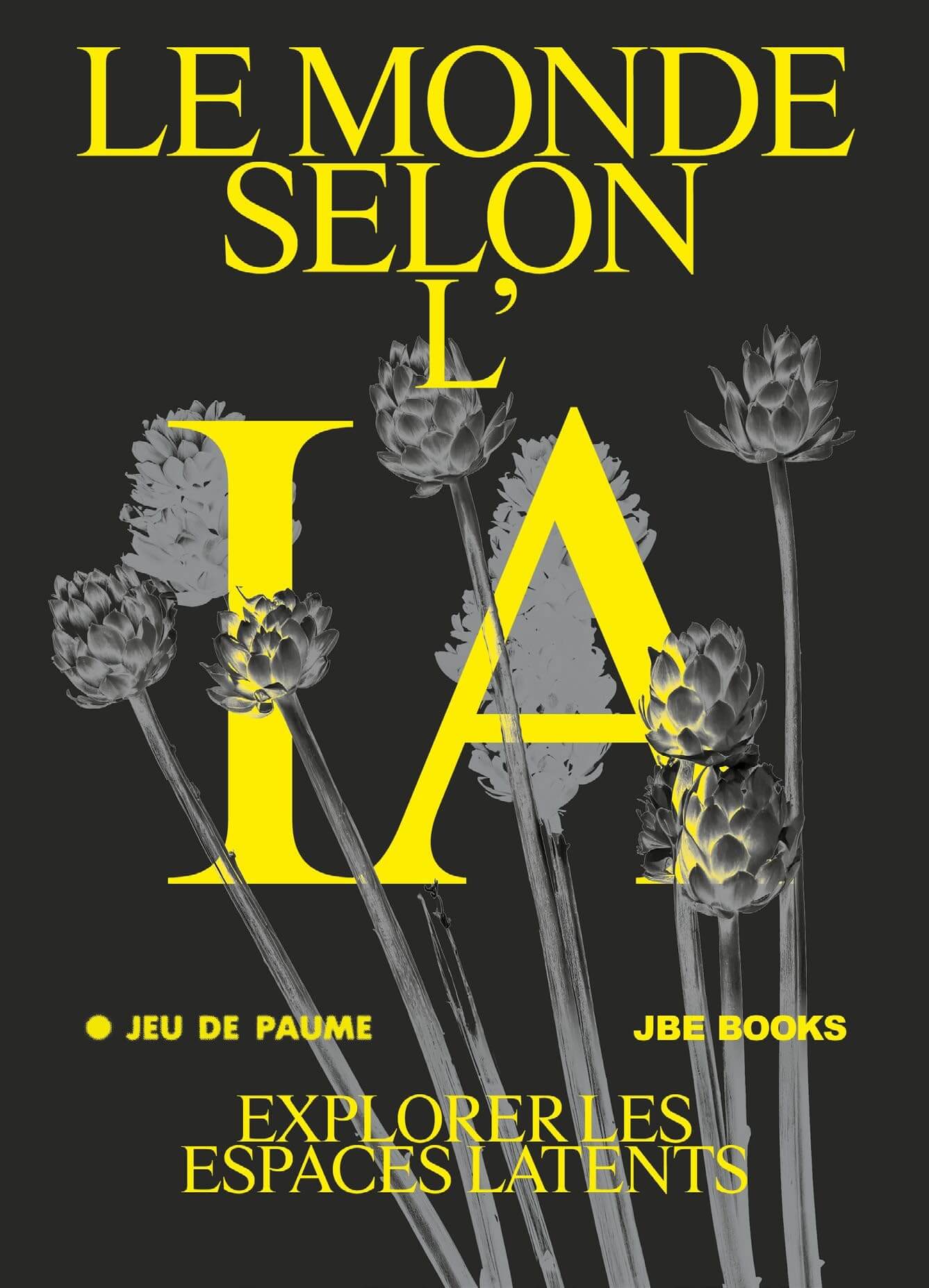 Catalogue « Le monde selon l’IA »
Catalogue « Le monde selon l’IA »
Coédition JBE Books × Jeu de Paume
Exposition au Jeu de Paume du 11 avril au 21 septembre 2025.
Sous la direction d’Antonio Somaini, commissaires associés : Ada Ackerman, Alexandre Gefen, Pia Viewing
Avec des textes de Ada Ackerman, Noam Elcott et Tim Trombley, Alexandre Gefen, Nick Monfort, Fabian Offert, Antonio Somaini, Joanna Zylinska
Design graphique : Atelier Pierre Pierre / Couverture souple et texturée, impression argentée
304 pages / 15,5 × 21,5 cm / 200+ illustrations
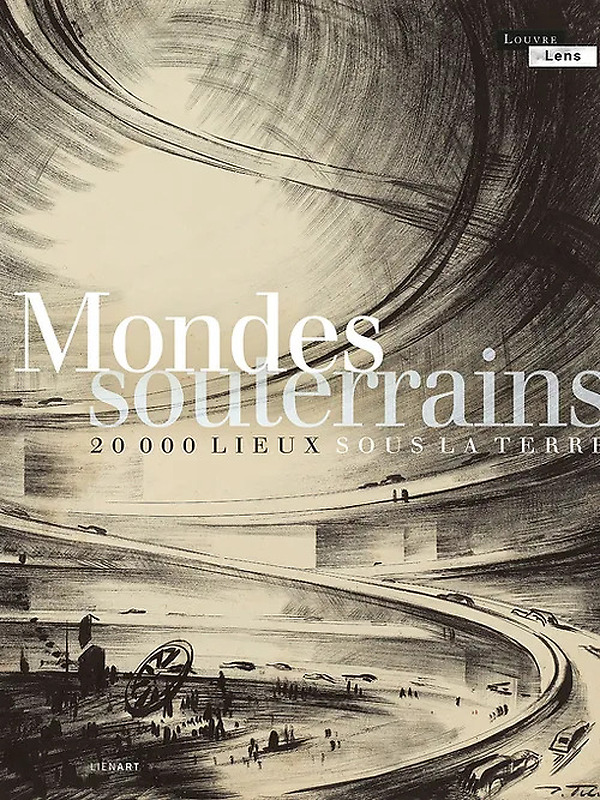 Catalogue « Mondes Souterrains »
Catalogue « Mondes Souterrains »
Louvre Lens
Liénart / Louvre-Lens, année de publication 2024
Dimensions 23,5 cm × 29,7 cm × 3,5 cm – 400 PAGES

Catalogue « Surreal Futures »
Exhibition catalogue Max Ernst Museum Brühl of the LVR, edited by Madeleine Frey & Patrick Blümel, Brühl 2023 (Wienand Cologne)
203 pages with numerous illustrations, edition in two languages (German/English), museum edition 29 €
https://maxernstmuseum.lvr.de/en/
E-mail: shop.mem@rheinlandkultur.de
 Superluminal, Light Art Museum Budapest, 2023-2024
Superluminal, Light Art Museum Budapest, 2023-2024
Through the works of more than 40 internationally renowned artists, the exhibition seeks to present light as a physical and natural phenomenon, an indicator of technological progress and a cultural construct endowed with symbolic meaning, in evergreen spaces, through light-installations and projections. The introduction to the publication is written by the curators Barnabás Bencsik and Borbála Szalai, while Sándor Hornyik was commissioned to write the essay. This exclusive catalogue, printed in 300 copies, is available in the museum shop.
https://lam.xyz/
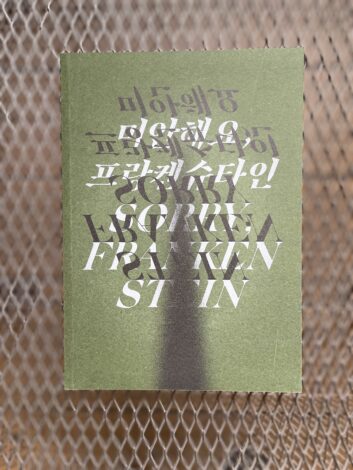 « Sorry, Frankenstein » Exhibition Catalogue, Jeonbuk Art Museum, South Korea
« Sorry, Frankenstein » Exhibition Catalogue, Jeonbuk Art Museum, South Korea
Sorry, Frankenstein
Whenever we encounter something new or unfamiliar, curiosity and fear intersect. Especially with the advancement of science and technology, whenever something new appears, mankind strives to get used to it, and we are witnessing the materialisation of substances and creatures that existed only in our imagination. Today, when the scope of discourse is expanding to include not only human life but also the reorganisation of the species surrounding humans, « Sorry, Frankenstein » is accompanied by works that create a kind of ontological rift between the expectations and anxieties of change in the post-COVID-19 era.
The exhibition looks at the world as a web of intertwined beings like a fabric, and attempts to break down the dichotomy between human and non-human by recognising the world not as a subject and object, but as a network of objects and their relationships. It is about looking differently at the behaviour of objects and organisms, material and immaterial, or beings that cross the boundary between them, from everyday mechanical devices, picture frames, or potted plants to dogs and rivers, and it is also about looking deeply into the way power works in this network of relationships. Therefore, it is not just a humanistic reflection or ethical reflection on beings in the position of the other, but a fundamentally different perception and practical sharing.
The lesson of the first science fiction novel, Frankenstein (Mary Shelley, 1818), is the tragedy of the fear of the unknown and the oppression that stems from it, behind the enthusiasm for technological novelty. But once we set aside the monstrous forms that were considered a threat to humans, we see a being that was simply ‘there’. Just as looking at something, whether it is familiar or not, can suddenly trigger a strange and uncanny emotional response, we are all a little bit of Frankenstein.
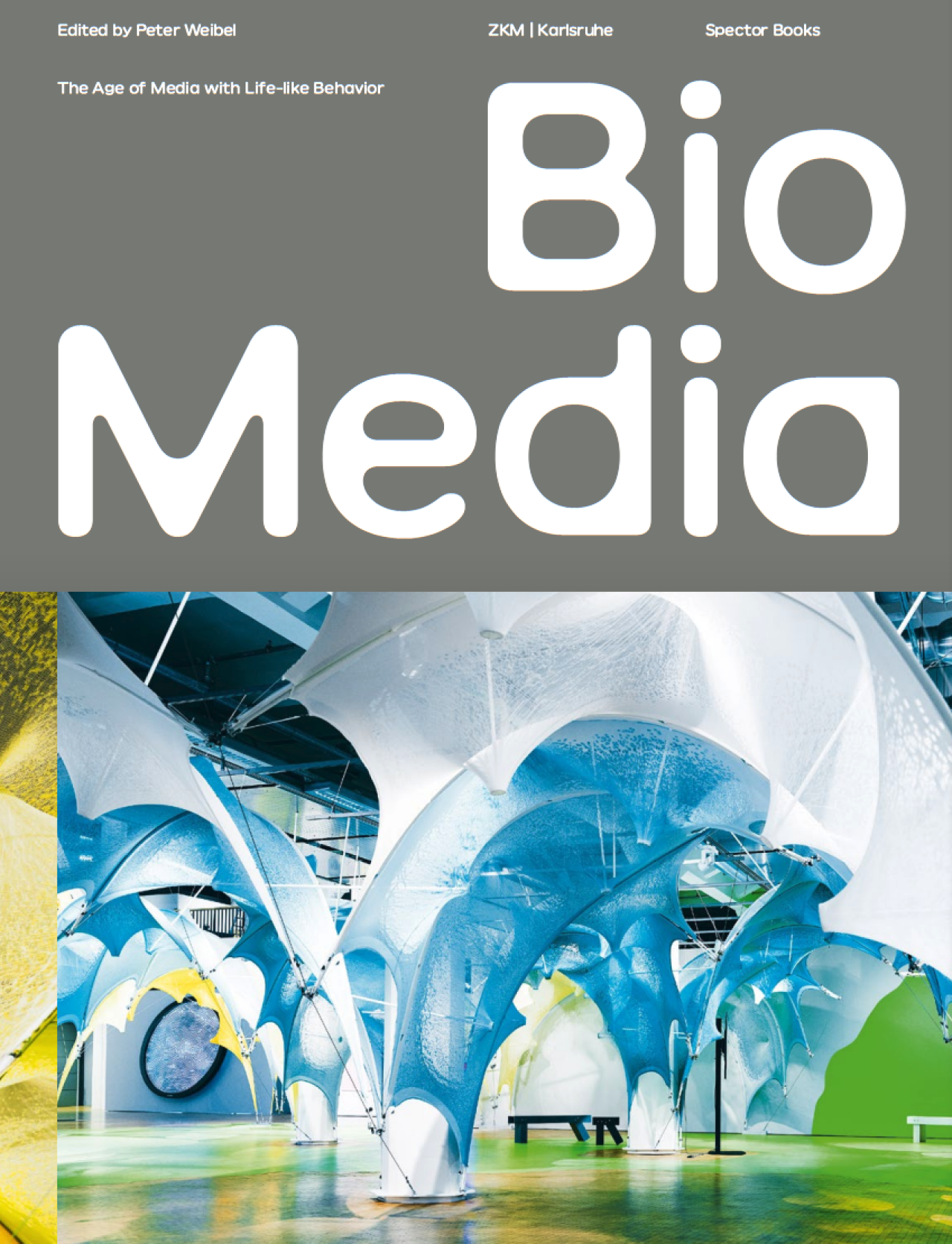 Bio Media, The Age of Media with Life-like Behavior | ZKM Center for Art and Media Karlsruhe, 2023
Bio Media, The Age of Media with Life-like Behavior | ZKM Center for Art and Media Karlsruhe, 2023
Exhibition catalog, Anthology
Author / Editor Peter Weibel (ed.) Publishing house, place Spector Books, Leipzig
2023
The nineteenth century was the era of moving machines, based on wheels (cars, trains, bicycles). The twentieth century was the epoch of moving images – which also started out being produced with wheel-based machines (film camera, film projector): the first steps towards the imitation of life by movement, sound, and color. With the subsequent introduction of the computer as a universal medium, media systems are characterized by the virtuality of information storage, the variability of image content, and the viability of image behavior. Therefore, the twenty-first century will see the rise of BioMedia. The term BioMedia or biomimetic media does not refer to Bio Art – art made with organic or biological material – but to art made with inorganic material that exhibits organic features: media that show life-like forms of behavior. The research exhibition »BioMedia. The Age of Media with Life-like Behavior« at ZKM | Center for Art and Media Karlsruhe presented dynamic media systems ranging from computer-generated and computer-simulated systems to complex adaptive robots and interactive installations which simulate various aspects of life beyond movement. These media systems are not living machines, but by virtue of their inputoutput relation and their reactions to the interactions of human and non-human entities, they act as living organisms in artificial and natural ecosystems. Over sixty artists and institutions have contributed works to the exhibition laying out these paradigmatic shifts in society and the arts. This book focuses on these artworks, which are described in detail in richly illustrated texts, presenting an overview of current developments of algorithms, artificial life, and artificial intelligence in art, but also features scientific essays by Peter Weibel, Samuel Bianchini and Emanuele Quinz, and Ingeborg Reichle.
Production / Corporation / Exhibition ZKM | Center for Art and Media Karlsruhe Organization / Institution ZKM | Center for Art and Media Team Project Management: Ulrike Havemann Design: Matter Of, Stuttgart. https://zkm.de/en/publication/biomedia
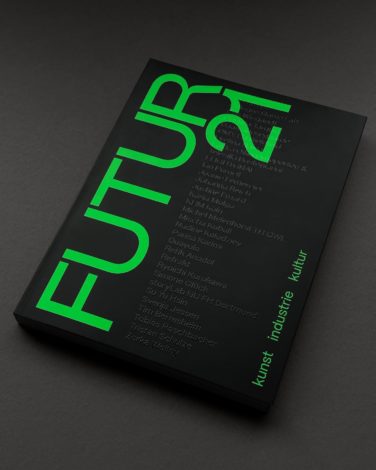 FUTUR 21 | Catalogue for the conference and festival of the Landschaftsverband Rheinland/ Landschaftsverband Westfalen-Lippe 2022
FUTUR 21 | Catalogue for the conference and festival of the Landschaftsverband Rheinland/ Landschaftsverband Westfalen-Lippe 2022
- herausgegeben von Ulrike Lubek, Landschaftsverband Rheinland, Landschaftsverband Westfalen-Lippe, Georg Lunemann
- Beiträge von Ulrike Lubek, Lea Althoff, Cornelia Bauer, Kirsten Baumann, Stefan Berger, Patrick Blümel, Joachim Breuninger, Corinna Franz, Manuel Grogos, Konrad Gutkowski, Walter Hauser, Milena Karabaic, Mischa Kuball, Matthias Löb, Rita Müller, Corine Pelluchon, Barbara Rüschoff-Parzinger, Petra Schaper-Rinkel, Thomas Schleper, Nada Schroer, Peter Paul Schwarz, Marion Steiner, Clemens Walter, Gabriele Zipf
- 256 Seiten, mit 134 farbigen und 28 s/w Abb, 28,0 cm x 21,0 cm
- Softcover, Deutsch / ISBN 978-3-86832-689-5
https://www.wienand-verlag.de/Programm/Zeitgenoessische-Kunst/FUTUR21-kunst-industrie-kultur.html
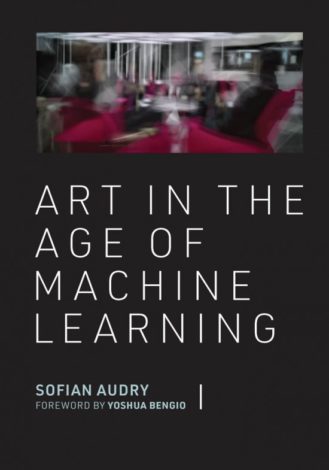 Art in the Age of Machine Learning | The MIT Press, 2021.
Art in the Age of Machine Learning | The MIT Press, 2021.
By Sofian Audry
Foreword by Yoshua Bengio
An examination of machine learning art and its practice in new media art and music.
Over the past decade, an artistic movement has emerged that draws on machine learning as both inspiration and medium. In this book, transdisciplinary artist-researcher Sofian Audry examines artistic practices at the intersection of machine learning and new media art, providing conceptual tools and historical perspectives for new media artists, musicians, composers, writers, curators, and theorists. Audry looks at works from a broad range of practices, including new media installation, robotic art, visual art, electronic music and sound, and electronic literature, connecting machine learning art to such earlier artistic practices as cybernetics art, artificial life art, and evolutionary art. https://mitpress.mit.edu/books/art-age-machine-learning
 Chefs-d’œuvre du XXIe siècle, Dominique Moulon, Nouvelles éditions Scala, 2021.
Chefs-d’œuvre du XXIe siècle, Dominique Moulon, Nouvelles éditions Scala, 2021.
Si les artisans du Moyen-Âge s’accomplissaient dans la production d’un chef-d’œuvre, au XIXe siècle, avec l’avènement du musée, le chef-d’œuvre prend toute sa dimension pour qu’enfin les avant-gardes de l’art moderne ne s’en détournent. Cette notion ré-émerge pourtant en ce premier quart du XXIe siècle sur lequel on peut déjà porter un regard critique au travers des créations contemporaines qui l’illustrent si parfaitement. Les cinquante chefs-d’œuvre rassemblés dans cet ouvrage sont abordés par le prisme des problématiques contemporaines que soulèvent, entre autres, notre cohabitation avec les robots, la relation que nous entretenons avec l’intelligence artificielle, le flux des images et le traitement de nos données. Car les chefs-d’œuvre de la troisième révolution industrielle, ceux-là mêmes qui émergent tant de l’usage que de la critique des sciences et des technologies de l’innovation nous offrent autant de lectures du monde du tout digital d’aujourd’hui. Chaque création analysée permet de considérer ce qui, possiblement en elle, fait chef-d’œuvre !
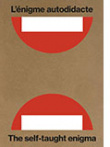
L’énigme autodidacte – The self-taught enigma, Musée d’art moderne et contemporain de Saint Etienne, 2021
Essais de Charlotte Laubard, Hélène Bézille, Lynne Cooke et Christophe Kihm, notices pour chacun des 44 artistes
exposés rédigées par Marie Applagnat, Arthur Dayras, Alexandre Quoi et Elsa Vettier. Bilingue français – anglais. Coédition avec avec les Éditions Snoeck.
Georges Adéagbo, Horst Ademeit, Raymonde Arcier, Marcel Bascoulard, Ben, Adelhyd van Bender, Guillaume Bijl, Irma Blank, Alighiero Boetti, Christian Boltanski, Marcel Broodthaers, Frédéric Bruly-Bouabré, Sophie Calle, Maurizio Cattelan, Ferdinand Cheval, Roberto Cuoghi, Henry Darger, Justine Emard, Robert Filliou, Richard Greaves, Chauncey Hare, Seydou Keïta, Bodys Isek Kingelez, Yves Klein, Emma Kunz, Jean Le Gac, Gianni Motti, Tania Mouraud, Arnold Odermatt, Francis Palanc, Présence Panchounette, Gianni Piacentino, Carol Rama, Jean-Pierre Raynaud, Carole Roussopoulos, Jean-Michel Sanéjouand, Judith Scott, Ceija Stojka, Miroslav Tichý, Jeanne Tripier, Wendy Vainity, Galaxia Wang, George Widener, Adolf Wölfli.
340 pages. Prix : 45 euros.
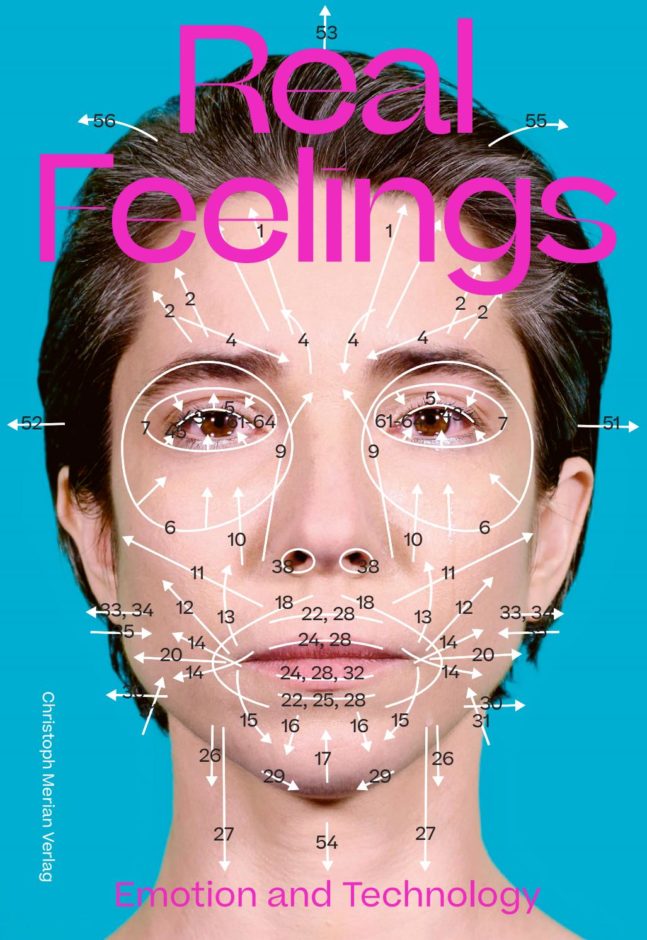 2020 – « Real Feelings. Emotion and Technology », Catalogue of the exhibition, HEK, Basel
2020 – « Real Feelings. Emotion and Technology », Catalogue of the exhibition, HEK, Basel
Christoph Merian Verlag, 2020
Sabine Himmelsbach, Ariane Koek, Angelique Spaninks (eds.)
Our everyday life is determined by digital technology in all areas of life: Human-like robots are used in health care, sex robots compensate for the deficits of human relationships, intelligent devices listen to our conversations and take care of our needs – we communicate more with our technology than with other people. The publication Real Feelings examines the rapidly changing relationship between technology and emotions and presents works by 20 international artists. They explore how technology today represents, manipulates and changes the way we feel.
With contributions by curators Sabine Himmelsbach, Ariana Koek and Angelique Spaninks as well as António Damásio, neuroscientist and bestselling author and artist Cécile B. Evans. Price: 29 CHF (zzgl. Versandkosten)
 2020 – « FUTURE AND THE ARTS », Mori Art Museum, Tokyo
2020 – « FUTURE AND THE ARTS », Mori Art Museum, Tokyo
Exhibition’s Catalogue
Essays by: Nanjo Fumio (Director, Mori Art Museum)
Igarashi Taro (Architectural Critic / Professor, Tohoku University)
Kubota Akihiro (Professor, Tama Art University / Artist)
Marie-Ange Brayer (The Head of the Design and industrial Prospective Department at Centre Pompidou, Musée National d’Art Moderne / Centre de Création Industrielle, Paris)
Honor Harger (Executive Director, ArtScience Museum, Singapore)
Kate Crawford (Director of Research, AI Now Institute at New York University; Distinguished Research Professor, New York University)
Price: 3,520 yen (incl. tax), date of Issue: December 27, 2019
Edited & Published by: Mori Art Museum, Tokyo; Bijutsu Shuppan-Sha Co., Ltd.
 2019 – « DESIRE: A REVISION FROM THE 20TH CENTURY TO THE DIGITAL AGE »
2019 – « DESIRE: A REVISION FROM THE 20TH CENTURY TO THE DIGITAL AGE »
Modern Art Museum, Dublin, Ireland
This publication accompanies the exhibition, Desire: A Revision from the 20th Century to the Digital Age, featuring contributions from the exhibiting artists, co-curators and key contemporary thinkers from a variety of fields, ranging from poetry and philosophy to architecture and performance, including Sasha Bonét, Vaari Claffey, Pádraic E. Moore, Yuko Hasegawa, Johanna Hedva, Jonah King, Aidan Mathews, Eddie Peake, Mario Perniola, Jennie Taylor and Nathalie Weadick.

2019 – « AI MORE THAN HUMAN » Barbican center, London, UK
« The AI: More than Human » catalogue considers the philosophical, scientific and artistic approaches to artificial intelligence; exploring and expanding on the themes and content of the exhibition.
With 250 pages of illustrated content, the catalogue features introductions by the exhibition’s curators, and essays and conversations from key figures and thinkers in the field.
The exhibition AI: More than Human is at the Barbican from 16 May to 26 Aug 2019.
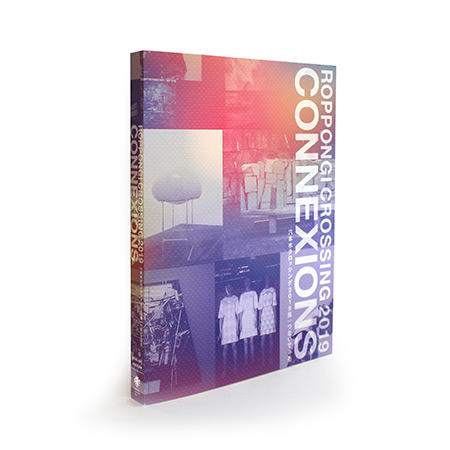 2019 – Exhibition’s Catalogue « Roppongi Crossing 2019: Connexions », Mori Art Museum, Tokyo
2019 – Exhibition’s Catalogue « Roppongi Crossing 2019: Connexions », Mori Art Museum, Tokyo
Essays by: Tsubaki Reiko (Curator, Mori Art Museum), Tokuyama Hirokazu (Associate Curator, Mori Art Museum), Kumakura Haruko (Assistant Curator, Mori Art Museum), Ozaki Tetsuya (Journalist, Art director), Clélia Zernik (Art critic; Professor, L’École Nationale Supérieure des Beaux-Arts; Philosopher), Hasegawa Arata (Independent curator)
Date of Issue: March 19, 2019
Edited & Published by: Mori Art Museum, Tokyo and Bijutsu Shuppan-Sha Co., Ltd.
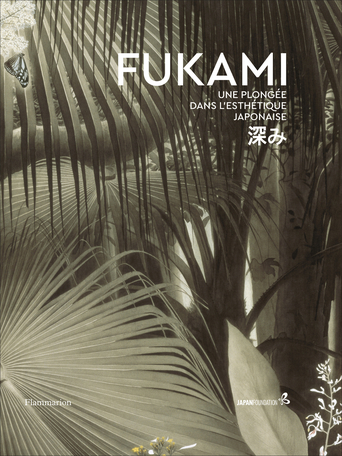 2019 -Catalogue d’exposition « Fukami, une plongée dans l’esthétique japonaise, » Hôtel Salomon de Rothschild, Yuko Hasegawa
2019 -Catalogue d’exposition « Fukami, une plongée dans l’esthétique japonaise, » Hôtel Salomon de Rothschild, Yuko Hasegawa
Avec les essais (Commissaire: Yuko Hasegawa, Philosophe: Christine Buci-Glucksmann, Historiens d’art: Nobuo Tsuji, et les autres)
Edité par Editions Flammarion
À paraître le 24/04/2019
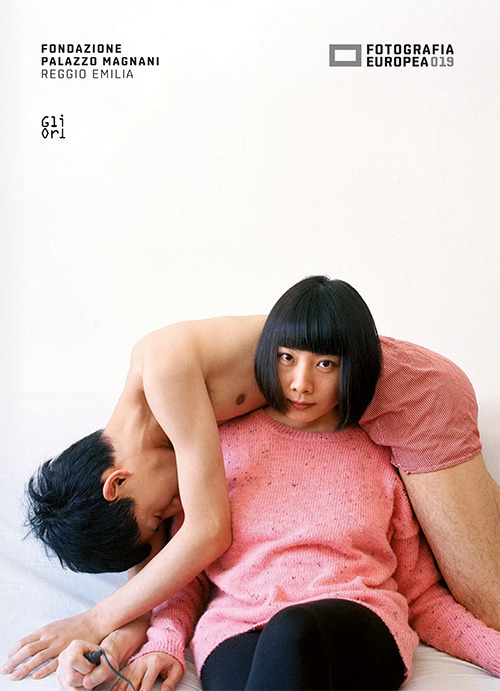 2019 – BONDING. Intimacy, Relationships, New worlds
2019 – BONDING. Intimacy, Relationships, New worlds
Fotografia Europea 2019 catalogue
Publisher: Gli Ori
Italian / English
Format 24 x 17 cm
256 pages
251 color photographs Price 28 €
Essays in the catalog by: Walter Guadagnini, Vanni Codeluppi
Solo exhibitions: Horst P. Horst, Larry Fink, Vincenzo Castella, Giovanni Chiaramonte, Michele Nastasi, Francesco Jodice, Vittorio Mortarotti, Jacopo Benassi, Pixy Liao, Kenta Cobayashi, Ryuichi Ishikawa, Motoyuki Daifu, Samuel Gratacap, Justine Emard, Pietrfrancesco Celada, Jaakko kahilaniemi, Lucie Khahoutian
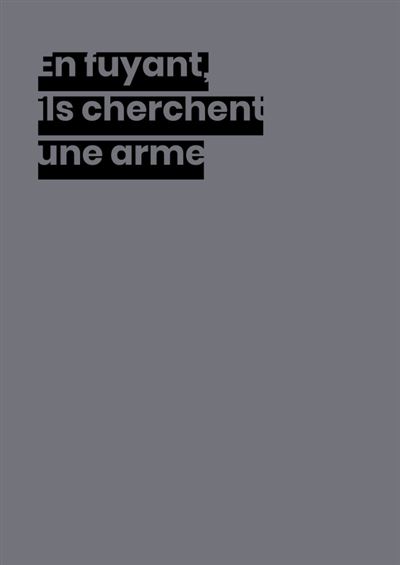 2019 Catalogue d’exposition – « En fuyant, ils cherchent une arme » Stéphanie Vidal
2019 Catalogue d’exposition – « En fuyant, ils cherchent une arme » Stéphanie Vidal
Maison Populaire de Montreuil, France
« En fuyant ils cherchent une arme » est un cycle de trois expositions qui propose de montrer comment des artistes contemporains exposent, à travers leurs gestes, des modes de résistance. Engagées, activistes, militantes, ces actions ne peuvent qu’être revendiquées ; la résistance comme pratique clandestine n’est plus : nous entrons dans l’époque des résistances ouvertes. Si l’art c’est ce qui résiste, alors nous pouvons nous demander ce qu’est résister, en art, aujourd’hui. Quelles sont les conditions d’émergence et de puissance d’un art en résistance maintenant que la consistance du monde a changé ? Selon Deleuze, ce serait sur les ruines, sur la panique et sur les lignes de fuite que la création adviendrait. Les oeuvres présentées dans l’ensemble de ce cycle sont nées de cette agitation. En prise avec l’époque, elles prennent toutes la forme du désir impérieux de créer des ensembles inédits en prenant en compte les singularités. Cet ouvrage fait la synthèse de l’exposition en trois temps présentée tout au long de l’année à la Maison Populaire de Montreuil.
(…)